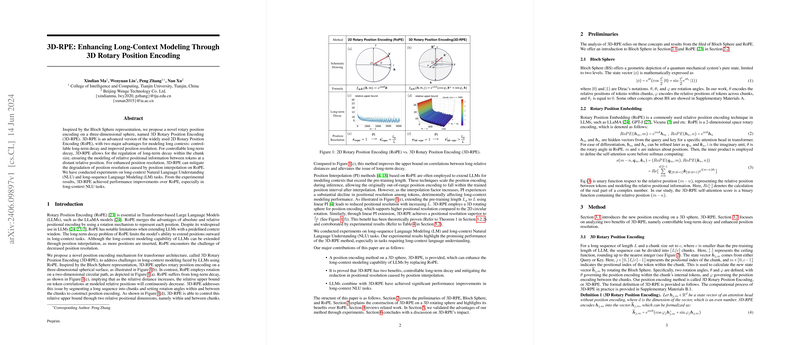Overview of 3D-RPE: Enhancing Long-Context Modeling Through 3D Rotary Position Encoding
This essay provides a detailed examination of a research paper titled "3D-RPE: Enhancing Long-Context Modeling Through 3D Rotary Position Encoding" by Xindian Ma et al. The paper introduces a novel position encoding mechanism named 3D Rotary Position Encoding (3D-RPE) which is inspired by the Bloch Sphere representation. This approach is designed as an advancement over the traditional 2D Rotary Position Encoding (RoPE) to address the limitations in long-context modeling within LLMs.
Key Contributions
3D-RPE provides two main enhancements over the existing RoPE method:
- Controllable Long-Term Decay: Unlike RoPE, where long-term decay affects the model's ability to extend positions in long-context tasks, 3D-RPE allows for the regulation of decay within a chunked sequence. By setting rotation angles within and between chunks, 3D-RPE maintains an upper bound on token correlations even as relative distances increase.
- Improved Position Resolution: The 3D-RPE approach mitigates the degradation of position resolution that occurs with position interpolation in RoPE. This is crucial as it ensures that the model maintains higher positional accuracy over extended sequences compared to the conventional 2D methods.
The introduction of rotary position encoding on a three-dimensional sphere allows for better modeling of relative positional information between tokens over long distances without significant loss of resolution or increase in computational overhead.
Methodological Approach
The authors propose dividing a long sequence into chunks and applying rotary position encoding on a three-dimensional spherical surface. The encoding involves two relative positional dimensions expressed as rotation angles within and between chunks. This spatial representation improves the model's capabilities to retain and process positional information even across extended ranges.
The authors also introduce a new formulation for calculating self-attention scores that factor in these additional dimensions, thus offering a significant leap in modeling capacity and efficiency.
Experimental Results
Empirical evaluations across long-context Natural Language Understanding (NLU) and long-sequence LLMing (LM) tasks demonstrate that 3D-RPE outperforms the baseline RoPE, particularly in long-context NLU tasks. Notably, 3D-RPE offers significant improvements without the need for retraining from scratch or incurring prohibitive computational costs, making it both a pragmatic and effective solution for enhancing LLMs.
The theoretical advantages are substantiated with experimental results, as 3D-RPE shows marked improvements in perplexity scores across standard datasets when compared to existing methods. The improvements in accuracy and efficiency in tasks requiring enhanced contextual understanding highlight the practical implications and effectiveness of the 3D-RPE model.
Implications and Future Directions
3D-RPE represents an important advancement in position encoding for LLMs, especially those that require extensive long-range contextualization. Its ability to accurately and efficiently encode positional data across long sequences opens up opportunities for enhanced language understanding and generation tasks.
Theoretically, the use of a three-dimensional positional encoding space better reflects the complexities of human language and discourse, suggesting that more naturalistic modeling approaches may further benefit from this structure. Furthermore, integration with other modalities, such as visual data, could present new frontiers for research in multi-modal AI.
Overall, the proposal of 3D-RPE aligns well with the ongoing trajectory towards increasing the context window and capabilities of Transformer architectures, providing a strong foundation for future explorations and applications within artificial intelligence research.
